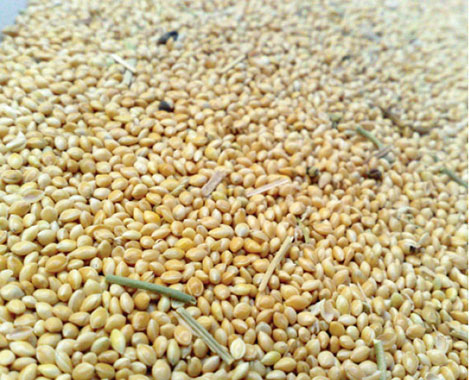illets are a group of highly-variable small-seeded grasses, widely grown around the world as cereal crops or grains for both human food and livestock feeds.
The husked grain of millet has a slightly nutty flavour and can be eaten whole after roasting, cooking, or boiling like rice.
Millet is fast becoming a popular baby food, since the grains are rich in calcium and have a pleasant flavour. The flour is used for making mush, porridge, flat bread or chapatti. It is also used for making wine or beer.
The grain is feed for animals. The green plant is used as forage, but the quality of the straw is poor. Brooms are made from the straw. Starch from the grains is used for sizing textiles.
Millet remains a staple in the diets of about a third of the world’s population.
Rich in iron, B vitamins and calcium, millet has a mild corn flavour and is naturally gluten-free.
Sure, on first glance, you might be tempted to think that raw millet is birdseed. But these little brown beads have a really lovely and light texture when cooked. Due to the sticks and shaft that cause a sandy feel, so many have reduced or stopped the consumption of millets.
In preparing millet, also known as jero, as a paste for pap meal, it is important to follow these procedures. It is good to hand-pick shafts and stones from millet before the preparation process. For a large amount, a sieve will be appropriate.
1. Pound or grind the millet to break up the seeds in pieces.
2. Using a sieve or cheese cloth, run water into the pureed millet again to remove the chaff.
3. Soak millet overnight. Do not soak with hot water.
4. Rinse with fresh clean water.
5. Spread out in tray and leave out in sun to dry for a whole day.
6. Add blended garlic, ginger, little yaji spice and other spices
7. Sieve again to get rid of any unwanted stuff; this is to ensure that you do not feel pebbles when having it.
8. Get the flour completely dry.
The end product will be a highly-scented dry greyish powder that can last months.
Whenever you want to make porridge, all you have to do is take some and make into a paste as you would do for pap.
There are so many ways you can use your millet in the kitchen. Millet is commonly cooked as porridge to enjoy in the morning – it is a great meal when you are tired of oatmeal, but there are many other ways to use millet.
You can chuck raw millet into cookies, dough or quick breads for extra crunch. Millets can be used as thickeners in soups, or as a base for warm grain salads of your choice. You can also buy millet grits, which are extremely quick-cooking, and are wonderful in any preparation.
This olden grain, with its mildly sweet flavour, is tasty, soothing, non-acid, and has numerous beneficial nutrients. This readily available meal is one of the least allergenic meals.
Millet provides serotonin; a neurotransmitter which helps calm and soothe your moods.
It helps hydrate your colon (long, coiled, tube-like organ that removes water from digested food).
Millet also digests easily.
The magnesium in millet can help reduce the effect of migraines and heart attacks. Niacin (vitamin B3) in millet can help lower (bad) cholesterol. Phosphorus in the grain helps with fat absorption, body tissue repair and creating energy – phosphorus is an essential component of adenosine triphosphate (ATP), a precursor to energy in your body. It can also help lower risk of Type 2 diabetes.
The fibre from whole grains like millet has been shown to protect against breast cancer. Whole grains have been shown to protect against childhood asthma.

- Advertisement -
- Advertisement -
Must Read
Tunde Onakoya breaks Guinness World Record for chess marathon
Onakoya with the feat, surpassed the previous record set by Norwegian players, Hallvard Haug Flatebø and Sjur Ferkingstad in 2018











